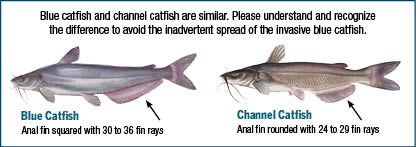Please see attached PDF.

Overview—. Blue catfish are native to the Mississippi, Missouri, and Ohio drainages, and were introduced into Virginia’s tidal rivers during the 1970s and 1980s. They are now extremely abundant and have been a controversial topic over the last decade. Some detest the species, citing perceived ecosystem changes after their introduction, while others rely on the fishery for their livelihood. After communicating with various angler groups in Virginia, it became clear to me that many members are frustrated with the media coverage of “invasive” blue catfish in the Chesapeake Bay. Local anglers are confused as to why blue catfish have been labeled as an invasive, while other non-natives have gotten a free pass.

MD DNR has posted this sign at numerous boat ramps. Why are non-native blue catfish (from the Mississippi River) labeled as invasive, while channel catfish (also from the Mississippi River) are not?
Definitions of “invasive species” vary broadly, and should be separated from “non-native” or “exotic” labels (Lockwood et al. 2013). Many people do not realize that most of Virginia’s freshwater fisheries revolve around non-native species, including largemouth bass, smallmouth bass, rainbow trout, brown trout, muskellunge, and channel catfish (Jenkins and Burkhead 1994). So why do blue catfish receive an invasive label? What separates them from all the other non-native fish that continue to be protected and stocked in Virginia waters?
Outreach Product—. My goal here is to develop a simple, streamlined blog post that provides an overview of the various definitions for an invasive species, much of which will come from Invasion Ecology (Lockweed et al. 2013). I will also address the definition of invasive species as defined by the National Invasive Species Council, which takes a more objective, quantitative approach to Executive Order 13112 (ISAC 2006). Further, I will review the history of non-native freshwater fish introductions, many of which have been very beneficial (Gozlan 2008; Gozlan et al. 2010).
After defining invasive species, I will present the most recent science on the life history of blue catfish within the Chesapeake Bay. I will then prompt readers to decide, based on the evidence, whether or not blue catfish should be labeled as an invasive in Virginia’s tidal rivers.
Desired impact—. I will clearly define what an invasive species is, while avoiding the jargon found in my source material (NISC 2006; Lockwood et al. 2013). I will also explore the history of non-native fish introductions throughout the U.S. and in Virginia. I will then briefly discuss the life history characteristics of blue catfish and ask the readership to decide, on their own, whether or not blue catfish should be considered an invasive species within the Chesapeake Bay. I want readers walking away with a clearer understanding of what an invasive species is, and I also want readers to understand the history of non-native fish in Virginia. Furthermore, I want readers to understand some of the basic biological characteristics of an invasive species, which I will then relate to blue catfish biology.
Desired audience—. My intended audience is Virginia angler groups who fish in VA tidal rivers. However, due to the ease of distributing information on the internet, I will also distribute the materials to other stakeholders that utilize Bay’ resources. This will be posted on my existing outreach website (www.chesapeakecatfish.com), and I hope to use peer evaluations to keep the materials clear and concise.
References
Gozlan, R. E. 2008. Introduction of non‐native freshwater fish: is it all bad? Fish and Fisheries 9(1):106-115.
Gozlan, R. E., Britton, J. R., Cowx, I., and G. H. Copp. 2010. Current knowledge on non‐native freshwater fish introductions. Journal of Fish Biology 76(4):751-786.
Jenkins, R. E., and N. M. Burkhead. 1994. Freshwater Fishes of Virginia. American Fisheries Society, Bethesda, Maryland.
(ISAC) Invasive Species Advisory Committee. 2006. Invasive species definition clarification and guidance white paper. National Invasive Species Council.US Department of Agriculture, National Agricultural Library. Washington, DC. Available at http://www.invasivespeciesinfo.gov/docs/council/isacdef.pdf. (Oct 2016).
Lockwood, J. L., Hoopes, M. F., and M. P. Marchetti. 2013. Invasion Ecology. John Wiley & Sons, Hoboken, New Jersey.